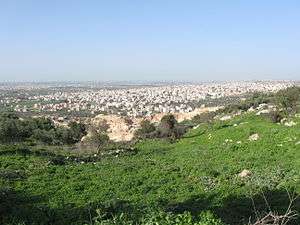Triangle (Israel)

The Triangle (Hebrew: המשולש, HaMeshulash; Arabic: المثلث, al-Muthallath), formerly referred to as the Little Triangle, is a concentration of Israeli Arab towns and villages adjacent to the Green Line, located in the eastern Sharon plain among the Samarian foothills; this area is located within the easternmost boundaries of both the Central District and Haifa District.
The Triangle is further divided into the Northern Triangle (around Kafr Qara, Ar'ara, Baqa al-Gharbiyye and Umm al-Fahm) and the Southern Triangle (around Qalansawe, Tayibe, Kafr Qasim, Tira, Kafr Bara and Jaljulia). Umm al-Fahm and Tayibe are the social, cultural and economic centers for Arab residents of the region. The Triangle is a stronghold of the Islamic Movement in Israel and Raed Salah, the current leader of the movement's northern faction is a former mayor of Umm al-Fahm.
History and status
Prior to the 1948 Arab–Israeli War and Israel's establishment and sovereignty over the Kafr Qasim, Jaljulia and Kafr Bara area, it was referred to as the "Little Triangle" to differentiate it from the larger "Triangle" region between Jenin, Tulkarm, and Nablus, renowned for extensive anti-Jewish attacks there during the 1936–39 Arab revolt.
The region was originally designated to fall under Transjordanian jurisdiction, but while negotiating the 1949 Armistice Agreements, Israel insisted on having it within its side of the Green Line, due to military and strategic reasons. To achieve this, a territorial swap was negotiated, ceding the Israeli territory in the southern hills of Hebron.[1][2] The term was later expanded to include the entire area around Wadi Ara (the Northern Triangle of today) and the "Little" appendage quickly fell out of common use.
Several Israeli politicians have suggested the Triangle should be transferred to a future Palestinian state in exchange for Israel retaining control over settlements in the West Bank. In a July 2000 survey conducted by Kul al-Arab among 1,000 residents of Umm al-Fahm, 83 percent of respondents opposed the idea of transferring their city to Palestinian jurisdiction.[3] The idea is a major plank of the Lieberman Plan put forward by Yisrael Beiteinu leader Avigdor Lieberman but is largely opposed by Israeli Arabs.[4]
See also
References
- ↑ Yisrael Ya'akov Yuval, "Where is the Green Line", Two Thousand, Vol. 29, no. 971, 2005 (Hebrew)
- ↑ Akiva Eldar (21 July 2006). "What is the Green Line". Haaretz (in Hebrew). Archived from the original on 5 June 2011.
- ↑ Kul Al-Arab (Nazareth, Israel), 28 July 2000, cited in Joseph Algazy (1 August 2000). "Um Al-Fahm Prefers Israel". Haaretz. archived at "Israeli Arabs Prefer Israel to Palestinian Authority". MEMRI. 10 August 2000.
- ↑ Fadi Eyadat (12 March 2007). "New poll shows 68.4% of Israeli Jews fear Israeli Arab uprising". Haaretz. Retrieved 21 August 2014.
Coordinates: 32°15′15″N 34°59′40″E / 32.25417°N 34.99444°E